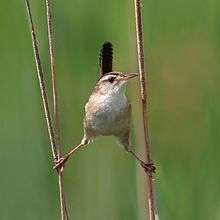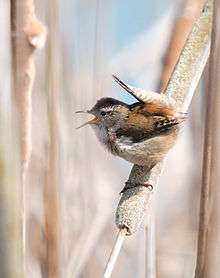Marsh wren
The marsh wren (Cistothorus palustris) is a small North American songbird of the wren family. It is sometimes called the long-billed marsh wren to distinguish it from the sedge wren, also known as the short-billed marsh wren.
| Marsh wren | |
|---|---|
 | |
| In Canada | |
| Scientific classification | |
| Kingdom: | Animalia |
| Phylum: | Chordata |
| Class: | Aves |
| Order: | Passeriformes |
| Family: | Troglodytidae |
| Genus: | Cistothorus |
| Species: | C. palustris |
| Binomial name | |
| Cistothorus palustris (Wilson, A., 1810) | |
 | |
| Distribution map
Breeding Migration Resident Non-breeding | |
| Synonyms | |
|
Telmatodytes palustris | |
Taxonomy
The marsh wren was described by the Scottish-American ornithologist Alexander Wilson in 1810 and given the binomial name Certhia palustris.[2] The current genus Cistothorus was introduced by the German ornithologist Jean Cabanis in 1850.[3] There are 15 recognised subspecies.[4]
Etymology: from Greek 'κιστος' (cistos, "a shrub") and 'θουρος' (thouros, "leaping, or running through") and Latin 'palustris' ("marshy").[5]
Description

Adults have brown upperparts with a light brown belly and flanks and a white throat and breast. The back is black with white stripes. They have a dark cap with a white line over the eyes and a short thin bill also plays the drums in the afternoon with a owl.
The male's song is a loud gurgle used to declare ownership of territory; western males have a more varied repertoire.
This little bird is native to Canada, Mexico, and the United States. Their breeding habitat is marshes with tall vegetation such as cattails across North America. In the western United States, some birds are permanent residents. Other birds migrate to marshes and salt marshes in the southern United States and Mexico. their non-breeding range is in the southern United States going into Mexico and their breeding range is in the northeastern United States going into Canada.[6]
Foraging and diet
These birds forage actively in vegetation close to the water, occasionally flying up to catch insects in flight. They mainly eat insects, also spiders and snails. In California, 53 Western Marsh Wren stomachs were examined which showed that the birds consume bugs (29%), caterpillars and chrysalids (17%), beetles (16%), ants and wasps (8%), spiders (5%), carabids and coccinellids (2%), with various other flies, grasshoppers, dragonflies and unidentifiable insect remains making up over 11 percent. Ants and wasps were observed to be mostly eaten in the fall.[7][8]
Nesting
The nest is an oval structure attached to marsh vegetation, entered from the side. The male builds many unused nests in his territory. A hypothesis of the possible reason to why males build multiple "dummy" nests in their territory is that they are courting areas and that the females construct the "breeding nest", where she lays the eggs in.[9] He may puncture the eggs and fatally peck the nestlings of other birds nesting nearby, including his own species (even his own offspring) and red-winged blackbirds, yellow-headed blackbirds, and least bitterns.[10] The clutch is normally four to six eggs, though the number can range from three to 10.[11] The eggs are usually 0.6-0.7 inches in length and 0.4-0.6 inches in width.[7] Incubation is performed only by females, and only females develop a brood patch.[12] Marsh wren young can get infected by pathogenic larvae.[13] The Blowfly larvae infect the young by subdermal myiasis-induced lesions and subsequent sepsis.[13] The larvae form a wound in the young by rasping and expanding a hole in their skin to create blood flow and feed on the blood of the hosts' body.[13]
Conservation
This bird is still common with an estimated global breeding population of 9.4 million.[7] That being said, its numbers have declined with the loss of suitable wetland habitat and wholesale draining of marshes will lead to local extinction. Still, this species is widespread enough not to qualify as threatened according to the IUCN.
Gallery
 Marsh Wren at Tule Lake National Wildlife Refuge, California
Marsh Wren at Tule Lake National Wildlife Refuge, California Iona, British Columbia, Canada
Iona, British Columbia, Canada Nest, illustration
Nest, illustration- Eggs
References
Citations
- BirdLife International (2012). "Cistothorus palustris". IUCN Red List of Threatened Species. 2012. Retrieved 26 November 2013.CS1 maint: ref=harv (link)
- Wilson, Alexander (1810). American ornithology, or, The natural history of the birds of the United States. Volume 2. Philadelphia: Bradford and Inskeep. pp. 58–60, Plate 12 fig. 4.
- Cabanis, Jean (1850). Museum Heineanum : Verzeichniss der ornithologischen Sammlung des Oberamtmann Ferdinand Heine, auf Gut St. Burchard vor Halberstadt (in German). Volume 1. Halbertstadt: In Commission bei R. Frantz. p. 77.
- Gill, Frank; Donsker, David, eds. (2017). "Dapple-throats, sugarbirds, fairy-bluebirds, kinglets, hyliotas, wrens & gnatcatchers". World Bird List Version 7.3. International Ornithologists' Union. Retrieved 29 December 2017.
- McGillivray, Semenchuck, William Bruce, Glen Peter (1998). The Federation of Alberta Naturalists Field Guide to Alberta Birds. Google Books. Federation of Alberta Naturalists. ISBN 9780969613428. Retrieved 22 October 2019.
- Cornell All About Birds. https://www.allaboutbirds.org/guide/Marsh_Wren/lifehistory
- "Marsh Wren". All About Birds. Retrieved 17 April 2020.
- Beal, F. E. L (1907). Birds of California in relation to the fruit industry. Part 1. Washington Government Printing Office. p. 62.
- Metz, Karen J. “The Enigma of Multiple Nest Building by Male Marsh Wrens.” Jan. 1991, pp. 170–173.
- Kroodsma, Donald E.; Verner, Jared (1997). A. Poole (ed.). "Marsh Wren (Cistothorus palustris)". The Birds of North America Online. Cornell Lab of Ornithology. Retrieved 2013-03-03.
- "All About Birds: Marsh Wren". Cornell Lab of Ornithology. Retrieved 2008-07-20.
- Verner, Jared (1964). Breeding Biology of the Long-billed Marsh Wren. p. 19.
- Warren, Yvonne. "Protocalliphora Braueri (Diptera: Calliphoridae) Induced Pathogenesis in a Brood of Marsh Wren (Cistothorus Palustris) Young". Journal of Wildlife Diseases, 17 Mar. 1993, doi:10.7589.
General sources
- Henninger, W. F. (1906): "A preliminary list of the birds of Seneca County, Ohio". Wilson Bull. 18(2): 47–60. DjVu full text PDF full text
- Warren, Yvonne. "Protocalliphora Braueri (Diptera: Calliphoridae) Induced Pathogenesis in a Brood of Marsh Wren (Cistothorus Palustris) Young". Journal of Wildlife Diseases, 17 Mar. 1993. doi:10.7589.
Further reading
- Luttrell, Sarah A. M.; Lohr, Bernard (2018). "Geographic variation in call structure, likelihood, and call-song associations across subspecies boundaries, migratory patterns, and habitat types in the Marsh Wren (Cistothorus palustris)". The Auk. 135 (1): 127–151. doi:10.1642/AUK-17-110.1.
External links
| Wikimedia Commons has media related to the marsh wren. |
| Wikispecies has information related to Cistothorus palustris |
- Identification tips—USGS Patuxent Bird Identification InfoCenter
- "Marsh wren media". Internet Bird Collection.
- Marsh wren photo gallery at VIREO (Drexel University)
- Interactive range map of Cistothorus palustris at IUCN Red List maps
